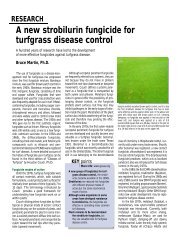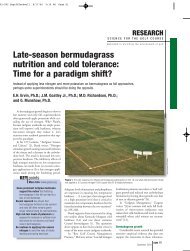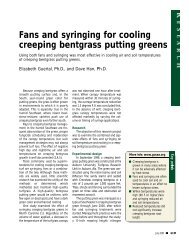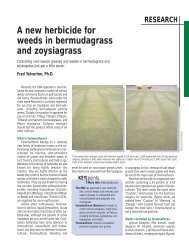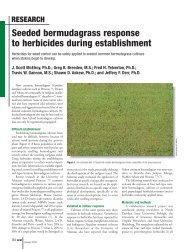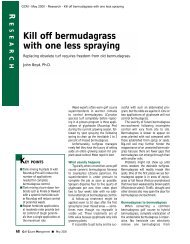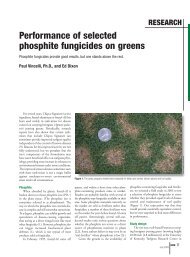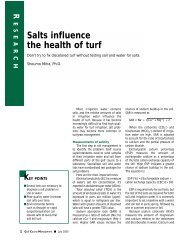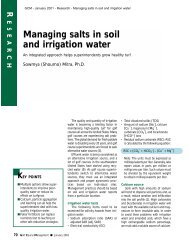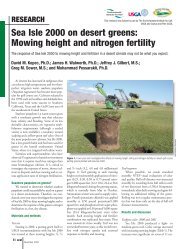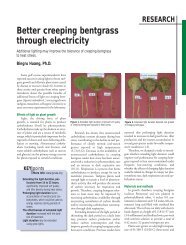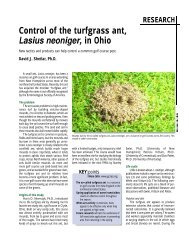consistently highest among <strong>seeded</strong> <strong>cultivars</strong>in rhizome density. Princess, one<strong>of</strong> the denser <strong>cultivars</strong>, had few rhizomeson some dates <strong>of</strong> measurement.Other <strong>cultivars</strong> with high rhizomedensity were Sundance and ED1. Most<strong>cultivars</strong> were not significantly differentfrom Arizona Common. Tifwayproduced more rhizomes than any<strong>seeded</strong> cultivar.Spring green-upSpring green-up <strong>of</strong> <strong>bermudagrass</strong>should not be confused with winter survival.We applied the spring green-uprating in years when temperatures hadbeen mild and there was no significantwinterkill.Spring green-up indicates the rate atwhich the <strong>cultivars</strong> break winter dormancyand begin spring growth. In thetest that we <strong>seeded</strong> in 1996, all plots survivedthe two winters that followed, but<strong>cultivars</strong> responded differently to thetwo different winters. In 1997, Guymondisplayed the earliest green-up, whileTifway and Arizona Common rankedamong the latest. In 1998, Tifway wasearly, while Guymon ranked among thelatest, with Arizona Common.Savannah displayedimproved springgreen-up over NuMexSahara and ArizonaCommon in bothyears <strong>of</strong> rating. Severalyears <strong>of</strong> evaluation areneeded to properlyrank the spring greenup<strong>of</strong> these <strong>cultivars</strong>.The minimum air temperature was near0 F.Local golf courses and some sodfarms experienced extensive winterkill<strong>of</strong> Tifway. Many fairways requiredreplanting, and Tifway sod was in shortsupply. Should fairways be plantedwith seed?Our Tifway plots established fromvegetative plugs in July displayed 55 percentwinter survival. Among the <strong>seeded</strong><strong>cultivars</strong>, Guymon averaged 17 percentsurvival while other <strong>cultivars</strong> displayed0 to 3 percent. Most <strong>of</strong> the same <strong>cultivars</strong>were re<strong>seeded</strong> in June 1996 withonly minimal winter injury observedthe following spring.Our plots for the 1997 national<strong>bermudagrass</strong> test were planted July 10,1997. All plots — vegetative and <strong>seeded</strong>— were well established and under routinemowing before frost and winterdormancy. The 1997-1998 winter wasmild with the minimum air temperatureapproximately 20 F. Even so, the<strong>seeded</strong> <strong>cultivars</strong> suffered severe winterinjury. Vegetative <strong>cultivars</strong> (includingTifway) in the same test and <strong>seeded</strong> cul-continuedR E S E A R C HWinter survivalWe believe thepotential for winterkillduring theestablishment year is acritical factor indeciding whether toestablish <strong>bermudagrass</strong>from seed. Thefirst <strong>of</strong> these tests was<strong>seeded</strong> on June 22,1995. The followingwinter in Mississippiwas considered severe.After the severe winter <strong>of</strong> 1995-96, Tifway <strong>bermudagrass</strong> displayed better survival than any <strong>seeded</strong> cultivar.Golf Course Management ■ November 1998 4
continued from p. 65tivars in the adjacent 1996 plantingshowed almost no injury.Among the <strong>seeded</strong> <strong>cultivars</strong> in the1997 test, Princess and the experimental<strong>cultivars</strong> PST-R69C, SW 1-11 andOKS 95-1 had the best winter survival(greater than 80 percent survival comparedwith Arizona Common at 18 percent).Because this was a mild winter itshould not be concluded that the<strong>seeded</strong> <strong>cultivars</strong> with higher winter survivalin the establishment year are morecold tolerant.For our region we recommend seeding<strong>bermudagrass</strong> in spring and earlysummer if it will be maintained at lowmowing heights because close mowingincreases winterkill <strong>of</strong> <strong>bermudagrass</strong>. Iflate seeding is necessary, then raising themowing height late in the growing seasonmay increase chances <strong>of</strong> success.AvailabilitySeed production is <strong>of</strong>ten traded awayas breeders strive to improve the turfqualities <strong>of</strong> <strong>cultivars</strong>. That means it’s<strong>of</strong>ten hardest to obtain seed for thebest grasses.We contacted the sources <strong>of</strong> the topthree <strong>seeded</strong> <strong>bermudagrass</strong>es —Princess, Sundance and Savannah —and found that the initial seed production<strong>of</strong> Princess (Seeds West Inc.) waslow, and the seed was not widely availablein 1998. Better availability isexpected in 1999. Seed yield <strong>of</strong>Sundance (Lesco) has been unacceptable.Sundance II has been selected forimproved seed yield. We look forward toevaluating Sundance II’s turf qualitybeginning in 1999. Supply <strong>of</strong> Savannah(Pure Seed Testing) is also limited atpresent but should be good by 2000.SummaryNew <strong>seeded</strong> <strong>bermudagrass</strong> <strong>cultivars</strong><strong>of</strong>fer improvements in turf density, leaftexture and turf quality. Lower and moreprostrate growth habit enables these new<strong>cultivars</strong> to perform at lower mowingheights than Arizona Common.Late seeding combined with lowmowing height may result in poor wintersurvival during the establishment year.Although the top turf performershave not yet produced enough seed tomeet demand, the future looks brightfor <strong>seeded</strong> <strong>bermudagrass</strong>. And although<strong>seeded</strong> <strong>cultivars</strong> have not met the <strong>performance</strong><strong>of</strong> Tifway, this goal is muchnearer than it was just a decade ago. ■References1. Alderson, J., and W.C. Sharp. 1994. Grass varietiesin the United States. USDA Agric.Handbook No. 170. U.S. Government PrintingOffice, Washington, DC.2. Baltensperger, A.A. 1989. Registration <strong>of</strong>‘NuMex Sahara’ <strong>bermudagrass</strong>. Crop Science29:1326.3. Baltensperger, A.A., and V. Meier. 1993.Registration <strong>of</strong> ‘Sonesta’ <strong>bermudagrass</strong>. CropScience 33:876.4. Fraser, M.L., and C.A. Rose-Fricker. 1998.Registration <strong>of</strong> ‘Savannah’ <strong>bermudagrass</strong>. CropScience 38:279.5. Samudio, S.H., and A.D. Brede. 1997.Registration <strong>of</strong> ‘Jackpot’ <strong>bermudagrass</strong>. CropScience 37:1380.6. Samudio, S.H., and A.D. Brede. 1998.Registration <strong>of</strong> ‘Cheyenne’ <strong>bermudagrass</strong>.Crop Science 38:279.7. Samudio, S.H., and A.D. Brede. 1998.Registration <strong>of</strong> ‘Sundevil’ <strong>bermudagrass</strong>. CropScience 38:537-538.8. Taliaferro, C.M., R.M. Ahring and W.L.Richardson. 1983. Registration <strong>of</strong> ‘Guymon’<strong>bermudagrass</strong>. Crop Science 23:1219.R E S E A R C HEven after a mild winter in Mississippi in 1997-98, <strong>bermudagrass</strong> <strong>cultivars</strong> <strong>seeded</strong> in July 1997(front) displayed severe winter injury compared with second-year plots (back) <strong>seeded</strong> inJune 1996.H. Wayne Philley is senior research assistant inMississippi State University’s department <strong>of</strong> plantand soil sciences. Jeffrey V. Krans, Ph.D., is pr<strong>of</strong>essor<strong>of</strong> agronomy in the department.Golf Course Management ■ November 1998 5



